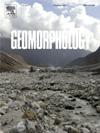Using geophysical subsurface data for the reconstruction of valley-scale spatio-temporal floodplain evolution: Implications for upland river restoration
IF 3.1
2区 地球科学
Q2 GEOGRAPHY, PHYSICAL
引用次数: 0
Abstract
The use of analogues of previous river styles is highly significant for successful river restoration, yet some existing techniques available to assist practitioners are still not widely applied. We explore the use of Ground Penetrating Radar (GPR), to explore past river styles in an upland river valley in the UK, and explore the potential of the approach to reconstruct former channel pattern. Post-glacial evolution of upland floodplains has been influenced by temporal changes in vegetation, sediment supply and hydrological regime. Channel-floodplain morphodynamics over the Holocene were conditioned by glacial deposits, lateral interaction with slope processes and fluvial sediment reworking, changes in flow and sediment supply regimes driven by climatic change, and more recently direct and indirect anthropogenic activities, e.g. deforestation, floodplain land use and channel modification. Current drives towards river restoration often use floodplain topography as a guide to appraise such a planform state, however, reconstruction of former channel state is often restricted to surface features visible on historic maps and aerial photographs. This research focuses upon the floodplain of the upper Swindale Beck, Lake District, UK, which was recently restored to a planform design based on the recent meander pattern visible in floodplain topography. We show the potential of GPR to reconstruct a wider array of past channel pattern and evolution at a site characterised by largely aggradational conditions and consistent sediment supply from glacial deposits at the valley head. Analysis of GPR data from 40 intersecting GPR survey lines revealed several stratigraphic units, including gravel braidplains, berms, chutes and bars, several levels of larger channels and their layered fill as well as backwater deposits. These were interpreted as braided systems, dynamic wandering planform and single-thread meandering systems with spatial transitions conditioned by tributaries and valley slope. Optically Stimulated Luminescence (OSL) dates in combination with GIS analysis of valley slope, channel gradient and local valley floor aspect allowed the interpretation of individual evolutionary stages of river and floodplain development at Swindale over at least the last millennium and provides links to processes in the wider environment including the role of alluvial fans in supplying sediment and forcing channel migration. Such information can be particularly valuable for restoration projects to aid design of channel dimensions, planform configuration, channel gradient, substrate characteristics and connection with tributaries. While restoration generally aims to resemble a more natural reference state, specific targets may seek to improve a particular set of functionalities (e.g., ecological, flood and sediment management, recreational) which should be resilient to the consequences of ongoing climatic changes and should be achieved sustainably (e.g. locally sourced gravel). Here, GPR-based floodplain analysis provides a non-invasive approach to understand possible evolutionary trajectories and to appraise a wider range of restoration options and sustainable resources.
利用地球物理地下数据重建山谷尺度的洪泛区时空演变:对高地河流恢复的影响
使用以前河流风格的类似物对成功修复河流意义重大,但现有的一些协助从业人员的技术仍未得到广泛应用。我们探讨了如何利用地面穿透雷达(GPR)来探索英国高地河谷过去的河流风格,并探讨了这种方法重建以前河道模式的潜力。高地洪泛平原冰川期后的演变受到植被、沉积物供应和水文系统时间变化的影响。全新世的河道-洪泛平原形态动力学受冰川沉积、与斜坡过程的横向相互作用和河道沉积物再加工、气候变化引起的水流和沉积物供应机制变化以及最近的直接和间接人类活动(如砍伐森林、洪泛平原土地利用和河道改造)的影响。目前的河流修复工作通常以洪泛区地形为指导来评估河道的平面状态,然而,对以前河道状态的重建往往局限于历史地图和航拍照片上可见的地表特征。本研究的重点是英国湖区 Swindale Beck 上游的洪泛区,该河道最近根据洪泛区地形中可见的近期蜿蜒模式恢复了平面设计。我们展示了 GPR 的潜力,它可以重建过去河道形态和演变的更广泛范围,该地点的特点是基本上处于侵蚀条件下,谷底的冰川沉积物持续不断地提供沉积物。对 40 条相交的 GPR 勘测线的 GPR 数据进行分析后,发现了多个地层单元,包括砾石辫状平原、护堤、槽沟和条石、几层较大的河道及其分层填充物以及回水沉积物。这些地层被解释为辫状系统、动态游荡平面和单线蜿蜒系统,其空间转换受支流和河谷坡度的影响。光学激发荧光(OSL)测定的日期结合地理信息系统(GIS)对河谷坡度、河道坡度和当地谷底坡度的分析,可以解释斯温代尔至少在过去一千年中河流和洪泛平原发展的各个演变阶段,并提供与更广泛环境过程的联系,包括冲积扇在提供沉积物和迫使河道迁移方面的作用。这些信息对修复项目特别有价值,有助于设计河道尺寸、平面构造、河道坡度、底质特征以及与支流的连接。一般来说,修复的目的是使河道更接近自然参考状态,而具体目标则可能是改善特定的功能(如生态、洪水和沉积物管理、娱乐),这些功能应能抵御持续气候变化的影响,并以可持续的方式实现(如就地取材的砾石)。在此,基于 GPR 的洪泛区分析提供了一种非侵入式方法,可用于了解可能的演变轨迹,并对更广泛的恢复方案和可持续资源进行评估。
本文章由计算机程序翻译,如有差异,请以英文原文为准。
求助全文
约1分钟内获得全文
求助全文
来源期刊

Geomorphology
地学-地球科学综合
CiteScore
8.00
自引率
10.30%
发文量
309
审稿时长
3.4 months
期刊介绍:
Our journal''s scope includes geomorphic themes of: tectonics and regional structure; glacial processes and landforms; fluvial sequences, Quaternary environmental change and dating; fluvial processes and landforms; mass movement, slopes and periglacial processes; hillslopes and soil erosion; weathering, karst and soils; aeolian processes and landforms, coastal dunes and arid environments; coastal and marine processes, estuaries and lakes; modelling, theoretical and quantitative geomorphology; DEM, GIS and remote sensing methods and applications; hazards, applied and planetary geomorphology; and volcanics.
 求助内容:
求助内容: 应助结果提醒方式:
应助结果提醒方式:


